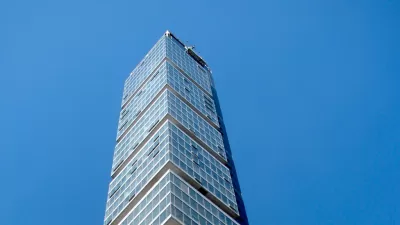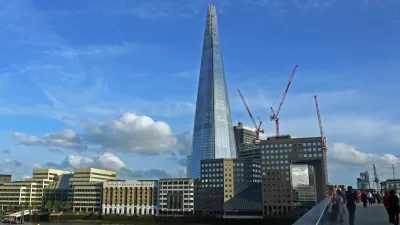Eliot Brown examines the global trend in skinny skyscrapers, as developers take advantage of technological advances and fatter wallets at the high end of the housing market to deliver stellar views.

In New York, Tel Aviv, and Vancouver tall thin towers are "sprouting like luxury beanstalks from small lots" for a clientele that can afford to subsidize their higher construction costs. According to Brown, "[f]ueling the drive toward slim living is an array of factors led by robust demand from the upper crust of the residential market willing to pay for premium views. Advances both in structural design and building materials have also made constructing skinny skyscrapers possible. In the end, higher prices mean developers can build on small sites that in the past wouldn't have allowed it."
"'If you can build more slender and higher, you can get more units with good views—and height is valued,' said Vancouver, British Columbia, developer Jon Stovell, who last year finished a 350-foot tower that has 4,850-square-foot floors."
"Building high, of course, gets expensive. As the floor count goes up, steel takes longer to lift and high winds can stall construction. Slender towers need a giant device, called a damper, toward the top to counter sway from wind. Without such features, buildings could rock to the point of making residents motion-sick."
"Technology has also helped give rise to the buildings," notes Brown. "For instance, the material of choice for apartment towers, steel-reinforced concrete, is more than twice as strong as a generation ago. Software in engineering offices can much better predict issues like how much a tower might sway, allowing for more efficient buildings with fewer columns," and of course, better views.
FULL STORY: Slim Pickings: The Rise of Skinny Skyscrapers

Alabama: Trump Terminates Settlements for Black Communities Harmed By Raw Sewage
Trump deemed the landmark civil rights agreement “illegal DEI and environmental justice policy.”

Study: Maui’s Plan to Convert Vacation Rentals to Long-Term Housing Could Cause Nearly $1 Billion Economic Loss
The plan would reduce visitor accommodation by 25% resulting in 1,900 jobs lost.

Planetizen Federal Action Tracker
A weekly monitor of how Trump’s orders and actions are impacting planners and planning in America.

Restoring Northern India’s Himalayan ‘Water Temples’
Thousands of centuries-old buildings protect the region’s natural springs and serve as community wells and gathering places.

Milwaukee to Double Bike Share Stations
Bublr Bikes, one of the nation’s most successful, will add 500 new e-bikes to its system.

DC Extends Application Window for Outdoor Dining Permits
District restaurants will have until the end of November to apply, but businesses with permits in rush hour parking lanes must end operations on July 31.
Urban Design for Planners 1: Software Tools
This six-course series explores essential urban design concepts using open source software and equips planners with the tools they need to participate fully in the urban design process.
Planning for Universal Design
Learn the tools for implementing Universal Design in planning regulations.
Caltrans
Smith Gee Studio
Institute for Housing and Urban Development Studies (IHS)
City of Grandview
Harvard GSD Executive Education
Toledo-Lucas County Plan Commissions
Salt Lake City
NYU Wagner Graduate School of Public Service



























